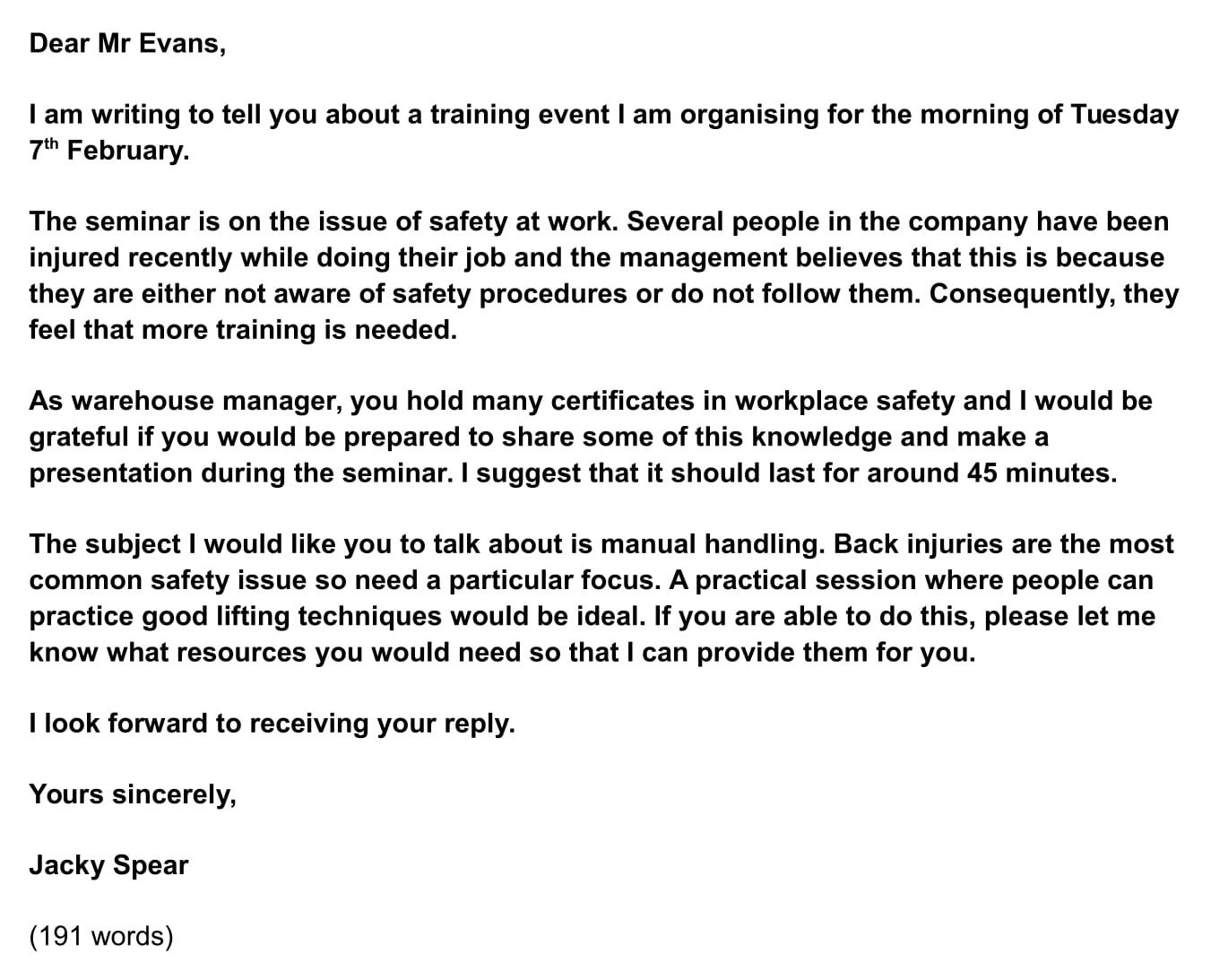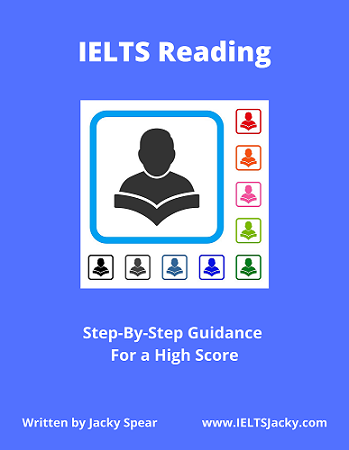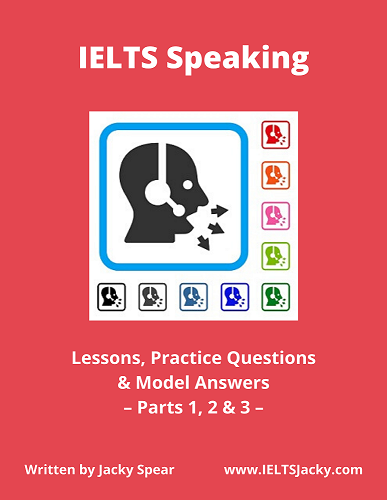IELTS Letter Writing Topics
How To Write an Invitation
Invitations are one of the 7 most common IELTS letter writing topics. In this lesson, I show you how to write an invitation letter step-by-step.
Here’s what the lesson includes:
- Question structure
- Letter structure
- Formal or informal?
- Greeting & signoff
- Generating ideas
- Sample
letters
Question structure
All questions for IELTS letters have the same structure. They are made up of 3 parts.
Part 1 – The topic.
Part 2 – The person you must write to.
Part 3 – What you should write about (listed as 3 bullet points).
Here is a sample question with the 3 parts illustrated.
IELTS letter writing topics - Invitation question 1
|
You are organising a seminar for your company. Write a letter to the manager of another department inviting them to give a presentation at the seminar. In your letter:
The topic Who you should write to What you should write about |
Understanding this will help you to quickly analyse the question and plan your answer. To help you plan, use the letter structure below.
For a full lesson on planning, including another IELTS letter sample, click here: How To Plan IELTS Letters
Letter structure
The layout of your letter should follow the structure of the question and consist of four paragraphs with a greeting at the beginning and a signoff at the end.
Use this easy to remember 6 part structure.
1) Dear .....
2) Paragraph 1: Purpose – why you are writing
3) Paragraph 2: Write about 1st bullet point
4) Paragraph 3: Write about 2nd bullet point
5) Paragraph 4: Write about 3rd bullet point
6) Signoff
All you need to do to create your plan is to add in the details from the question, like this:
1) Dear ..... (manager)
2) Paragraph 1: Purpose – tell the manager you are organising a seminar.
3) Paragraph 2: give details of the seminar (bullet point 1)
4) Paragraph 3: invite them to give a presentation & say why you are inviting them (bullet point 2)
5) Paragraph 4: say what the presentation should be about (bullet point 3)
6) Signoff
Formal & Informal Letters
IELTS letters must be written in the appropriate tone and style. There are two options:
- Formal – to someone you don’t know or don’t know well.
- Informal – to a friend.
It is essential that you are able to identify what type of question you’re required to write.
Follow this rule:
- If the question includes the word ‘friend’, use informal language.
- If the question does not include the word ‘friend’, use formal language.
To learn more about formal and informal letters and see sample letters of other IELTS letter writing topics, click here:
Although it is possible that you would be friendly with this manager, assume that you are not and keep this type of letter formal.
The Greeting & Signoff
The Greeting
There are two ways you can begin a formal letter.
- Use Dear Sir or Madam if you don’t know the name of the person you are writing to.
- Use Dear + surname if you do know their name, e.g. Dear Mr Smith or Dear Mrs Jones.
You would know the name of a manager from another department in your workplace so, make up a surname for them.
If you were writing an informal invitation letter to a friend, you would use their first name, e.g. ‘Dear Joanne’.
The greeting you use will determine how you sign off your letter.
The Signoff
For a formal letter, there are two main options. The correct one will depend on who you are addressing:
- Dear Mr Smith (name known) – Yours sincerely
- Dear Sir/Madam (name unknown) – Yours faithfully
You could also use ‘Kind regards’. This is formal but friendly and is appropriate for most situations. It is particularly useful if you struggle to remember how to spell ‘sincerely’ and ‘faithfully’.
Always sign off a formal letter with your full name, e.g. Jacky Spear
For an informal letter to a friend, use one of these phrases followed by your first name:
- All the best
- See you soon
- Keep in touch
For example,
See you soon,
Jacky
For our letter, we will use this greeting and signoff:
Dear Mr Evans...
....Yours sincerely,
Jacky Spear
We are now ready to think up some ideas to write about. We have the guidelines of the 3 bullet points to help us so this won’t be difficult.
How To Generate Ideas for IELTS Letters
You only have to write 150 words, so you won’t need many ideas but do make sure that you write about each bullet point and develop each idea fully.
They don't have to be the best ideas you can possibly think of. Go with your first thoughts and don’t waste time trying to think of better ideas. However, they must relate directly to the bullet points.
Note them beside each bullet point on the exam paper, like this:
You are organising a seminar for your company.
Write a letter to the manager of another department inviting them to give a presentation at the seminar. In your letter:
- give details of the seminar
Safety at work
- invite them to give a presentation and say why you are inviting them
Warehouse manager – most highly trained person in company
- say what the presentation should be about
Manual handling
That’s our planning complete. Once you’ve had some practice, you’ll be able to do this in just a few minutes. Taking time to plan makes writing IELTS letters far quicker and easier than if you don’t do this step. You will also write a better letter and get higher marks.
We're now ready to start writing our letter.
Writing the Letter
Here’s our plan again with all our notes added in.
1) Dear ..... (warehouse manager)
2) Paragraph 1: Purpose – to tell them about the seminar
3) Paragraph 2: give details of the seminar bullet point 1)
Safety at work
4) Paragraph 3: invite them to give a presentation and say why you are inviting them (bullet point 2)
Warehouse manager – most highly trained person in company
5) Paragraph 4: say what the presentation should be about (bullet point 3)
Manual handling
6) Signoff
We’ve already decided on the greeting so we’ll start with paragraph 1.
Paragraph 1
In the first paragraph, you must state the reason for writing the letter, that is, its purpose.
Paragraph 1: Purpose – to tell them about the seminar
Many students make the mistake of missing this purpose sentence out but it's very important. Including it will gain you marks.
It only requires one sentence. For example,
I am writing to tell you about a training event I am organising
for the morning of Tuesday 7th February.
Top vocabulary tip: Do not use contractions in formal letters. They are informal language. So, do not write ‘I’m writing to tell you…’
Paragraph 2
In the second paragraph, you write about bullet point 1.
Paragraph 2: give details of the
seminar (bullet point 1)
Safety at work
Remember to
keep the language formal. You could write something like this.
The seminar is on the issue of safety at work. Several people in the company have been injured recently while doing their job and the management believes that this is because they are either not aware of safety procedures or do not follow them. Consequently, they feel that more training is needed.
Paragraph 3
The third paragraph should cover the second bullet point.
Paragraph 3: invite them to give a
presentation and say why you are inviting them
(bullet point 2)
Warehouse manager – most highly trained person in company
As warehouse
manager, you hold many certificates in workplace safety and I would be grateful
if you would be prepared to share some of this knowledge and make a presentation
during the seminar. I suggest that it should last for around 45 minutes.
Paragraph 4
Paragraph 4 addresses the third bullet point.
Paragraph 4: say what the presentation should be about (bullet point 3)
Manual handling
The
subject I would like you to talk about is manual handling. Back injuries are
the most common safety issue so need a particular focus. A practical session
where people can practice good lifting techniques would be ideal. If you are
able to do this, please let me know what resources you would need so that I can
provide them for you.
Now we just need to add the signoff we decided on earlier and our letter is complete.
IELTS Letter Sample
Here is the finished letter.

Practice Question
To
get some practice writing this type of letter, write a letter for the question
below.
IELTS letter writing topics - Invitation question 2
You are organising a family party.
Write a letter to your friend inviting him/her to attend the party. In your letter:
- explain why you are organising the party
- say why you want your friend to come to the party
- describe what you are planning to do.
This
letter is to a friend so must be written in an informal tone and style. Use the
planning structure I showed you above to plan before you start writing.
Here’s a sample letter. Can you identify the language and grammar structures I’ve used to make it informal? Note the use of contractions.

You'll find sample letters on more IELTS letter writing topics in the lessons below.
|
Want to watch and listen to this lesson? Click on this video. |
Like this page?
Common IELTS Letter Writing Topics
IELTS General Writing Task 1 – All Lessons
These lesson include sample letters on many different IELTS letter writing topics.
IELTS General Writing – A summary of the test including important facts, test format & assessment.
Letter
Format – The format, the 7 topics, letter
structure, formal & informal, assessment & marking criteria, sample
questions. Essential information you need to know.
Letter Writing Tips – Learn top tips on how to meet the assessment and marking criteria and achieve a high score.
Letter Writing Structure – Find out how to use this easy to learn letter structure to write a high-scoring letter. Includes a model answer.
How To Plan a Letter – Learn a simple 5 step process & 6 part letter structure. Also, help to understand the question & generate ideas.
Formal or Informal – How to decide what type of
letter to write. Sample questions & 2 model letters.
Letter Writing Vocabulary – Learn useful phrases to help you achieve a high score. Also, know how to start & end your letter.
How To Write an Informal Letter – Step-by-step instructions, simple 4 step plan & 6 part letter structure, model letter.
How To Write a Formal Letter – Step-by-step instructions, simple 4 step plan & 6 part letter structure, model letter.
Letter Topics – Learn the 7 most common letter topics & other popular subjects. Includes 20 sample questions.







